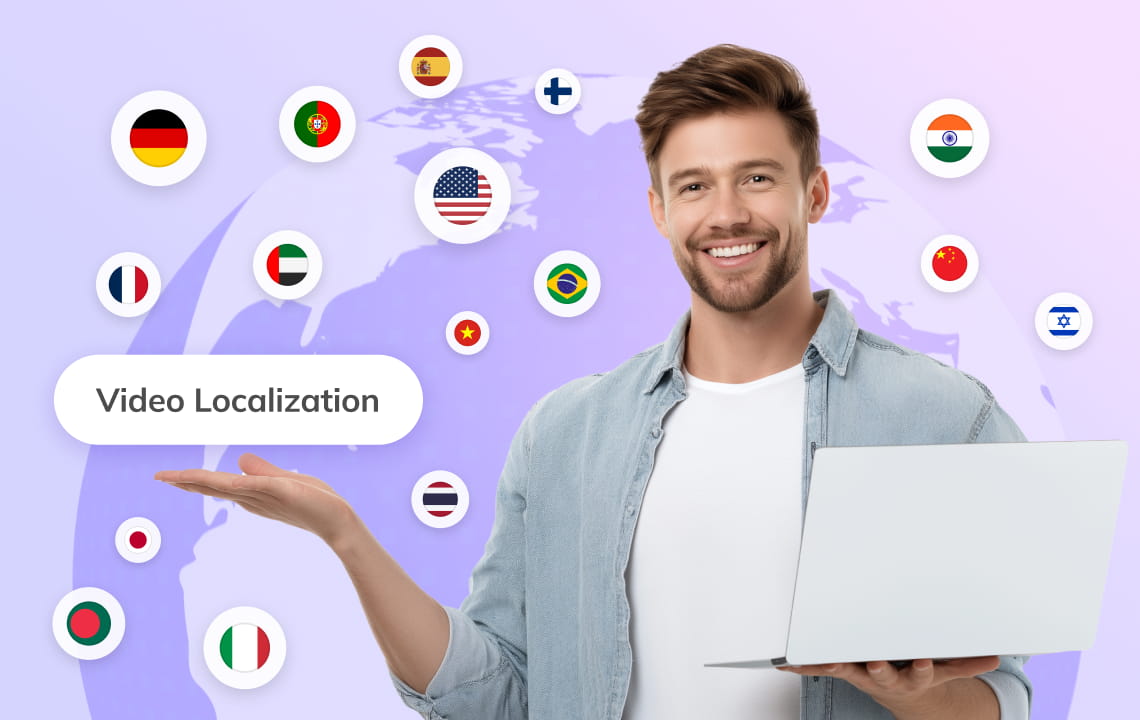
In an ever-growing, well-globalized digital world like this one, video has become a universal form of communication—but language remains a barrier. Studies show that over 80% of viewers prefer content in their native language, underscoring the importance of localization for businesses, educators, and creators seeking to reach global audiences.
Once a slow and costly process involving translators, voice actors, and editors, video localization is now powered by AI. With tools using speech recognition, voice cloning, and lip-sync technology, anyone can instantly adapt a single video into multiple languages. In this guide, you are going to find out what video localization means, why it matters, how it works, the best tools available in 2025, and how creators and companies can achieve professional multilingual results.
What Is Video Localization?
Video localization is the process of adapting a video's language, visuals, and cultural elements to suit diverse audiences worldwide. It ensures the content connects with viewers emotionally, linguistically, and culturally — going beyond simple translation.
Key elements include:
- Dubbing or Voiceover: Replacing the original audio with translated speech.
- Subtitles & Captions: Adding translated text for accessibility and multilingual viewers.
- On-Screen Text & Graphics: Adjusting visuals, UI, or currency formats for local relevance.
- Cultural Adaptation: Tweaking idioms, humor, or examples to fit local culture.
Unlike direct translation, localization ensures that jokes make sense, idioms feel natural, and visuals align with local expectations. For example, a U.S. brand might replace baseball references with football terms when adapting for European viewers.
Localization vs Translation vs Dubbing
| Process | Focus | Example |
| Translation | Converts text or speech into another language | English → Spanish subtitles |
| Dubbing | Replaces the original audio with another language | English audio → French voiceover |
| Localization | Full adaptation including translation, dubbing, visuals, and culture | Changes slang, graphics, idioms, and timing |
Why Video Localization Matters
Video localization isn’t just for global corporations—it benefits anyone reaching international audiences, from YouTubers to universities.
- Reach Global Audiences: Connect with non-English-speaking viewers and unlock new markets.
- Boost Engagement: People are more likely to watch and share videos in their native language.
- Improve Accessibility: Subtitles and voiceovers make content inclusive for all users.
- Ensure Brand Consistency: Deliver the same message and tone across regions.
With AI-powered localization, creators can now translate, dub, and subtitle videos faster and more affordably than traditional studio workflows—making global content creation easier than ever.

How Video Localization Works (Step-by-Step)
AI video localization typically consists of 6 major steps: transcribing the original audio, translating it, creating new voices, syncing lips, adding subtitles, and exporting the final video.
Modern AI platforms now automate the majority of these steps, reducing production time from days to hours while preserving near-human voice quality and synchronization.
The 5 Best Tools for Video Localization in 2025
AI-powered video localization tools are reshaping how creators and companies reach global audiences. Here are five standout solutions in 2025:
Quick Comparison Table
| Tool | Languages | Voice Cloning | Lip Sync | Subtitle Auto-Gen | Best For |
| VMEG AI | 170+ | ✅ Yes | ✅ Yes | ✅ Yes | Dubbing, Translation, Global Teams |
| Synthesia | 120+ | ❌ | ❌ (Avatar only) | ✅ | Training, Internal Videos |
| HeyGen | 100+ | Partial | ✅ | ✅ | Marketing, Social Videos |
| Deepdub | 80+ | ✅ | ✅ | ✅ | Film, TV, Entertainment |
| Descript | 25+ | ✅ | ❌ | ✅ | Podcasts, Voiceovers |
VMEG AI — Best for Multilingual Video Dubbing & Voice Cloning
VMEG AI is a comprehensive, browser-based platform designed for creators, educators, and global businesses who want to localize videos with professional precision. It supports 170+ languages and 7,000+ ultra-realistic cloned voices, enabling natural dubbing, lip-sync, and subtitle translation in a single workflow.
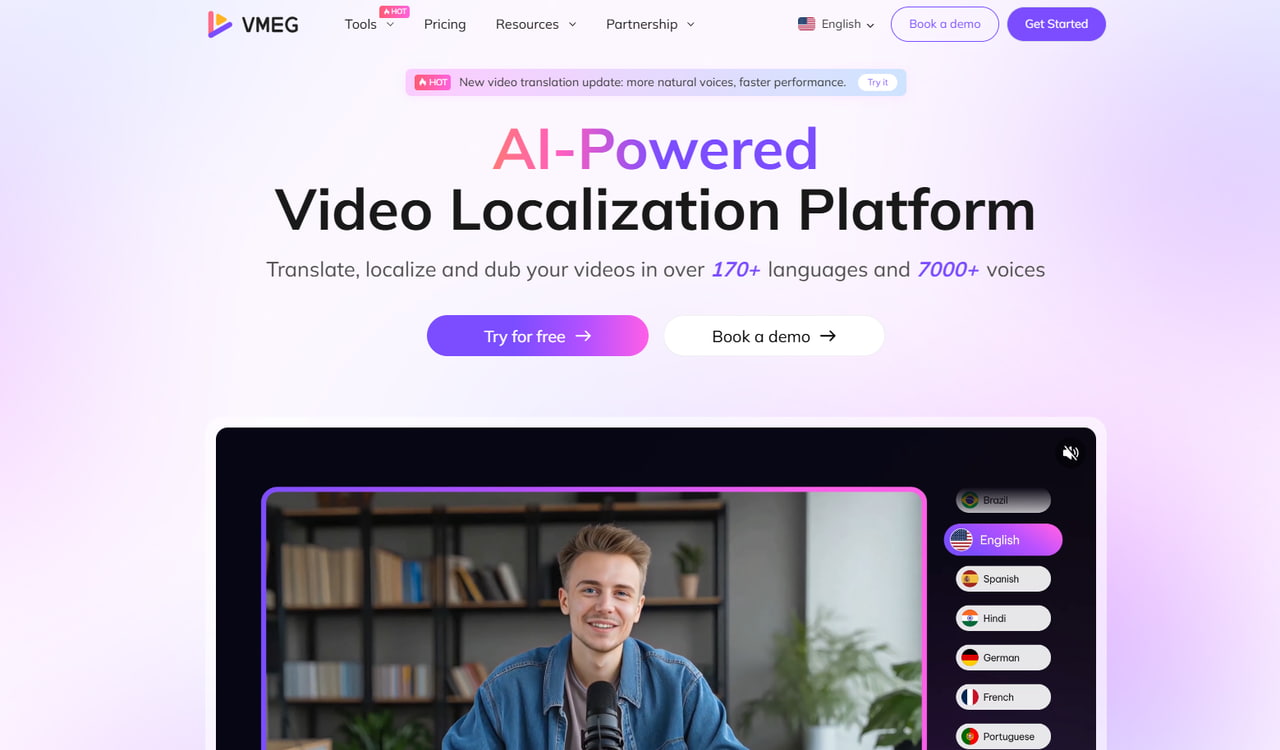
Key Features:
- Automatic translation and dubbing with AI-generated voices that retain emotion and tone.
- Voice cloning that replicates the original speaker’s vocal identity in multiple languages.
- Auto-subtitles and in-line translation editing for precise adjustments.
- Perfect lip-sync alignment, maintaining natural mouth movements and expression timing.
- Browser-based interface—no installation required; accessible from any device.
- Flexible export options (MP4, MOV, and SRT) for seamless upload to YouTube, TikTok, or eLearning platforms.
Best For: YouTubers, educators, training content producers, and international marketing teams aiming to reach global audiences efficiently.
Why VMEG Stands Out:
VMEG AI is the only localization tool offering global-language voice cloning across 170+ languages. Its combination of emotional realism, accurate lip-sync, and cross-language voice consistency makes it a go-to solution for anyone seeking high-quality multilingual dubbing without the traditional studio costs.
Synthesia
Synthesia remains one of the pioneers of AI avatar-based video creation. Instead of traditional dubbing, it lets users generate entire videos with virtual presenters speaking multiple languages. It’s especially popular in corporate settings where training and internal communication videos need to be updated frequently across regions.
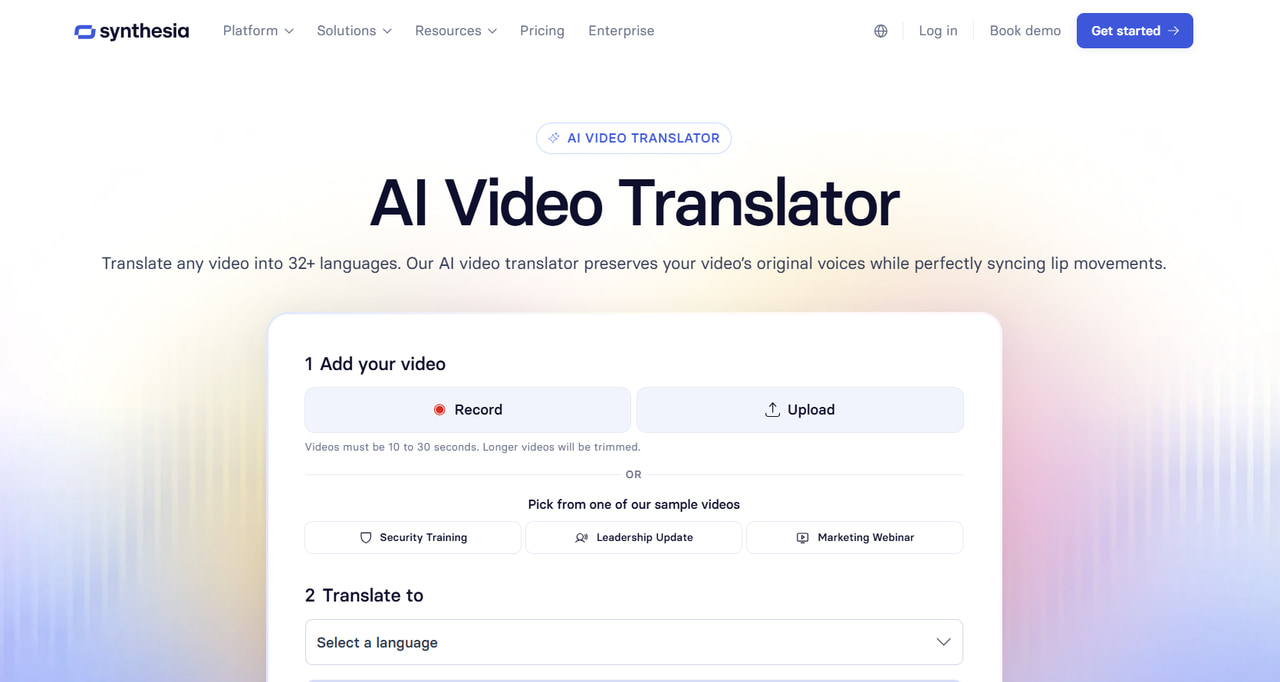
Key Features:
- 120+ supported languages with native-like AI voices.
- AI avatars that display gestures, facial expressions, and lip-sync in sync with scripts.
- Script-to-video automation, turning text prompts directly into localized video content.
- Custom branding and template options for enterprise workflows.
Limitations:
- No true voice cloning — all voiceovers come from pre-generated voices.
- Lip-sync applies only to avatars, not real human footage.
- Less suitable for creators who want to localize live-action videos.
Best For: Corporate training, HR onboarding, internal communications, and explainers where visual consistency and clarity are prioritized over emotional realism.
HeyGen
HeyGen bridges the gap between AI avatar generation and automated video dubbing, making it a strong contender for marketing and influencer content. The platform emphasizes personalization, enabling users to create customized talking-head videos that can speak in multiple languages.
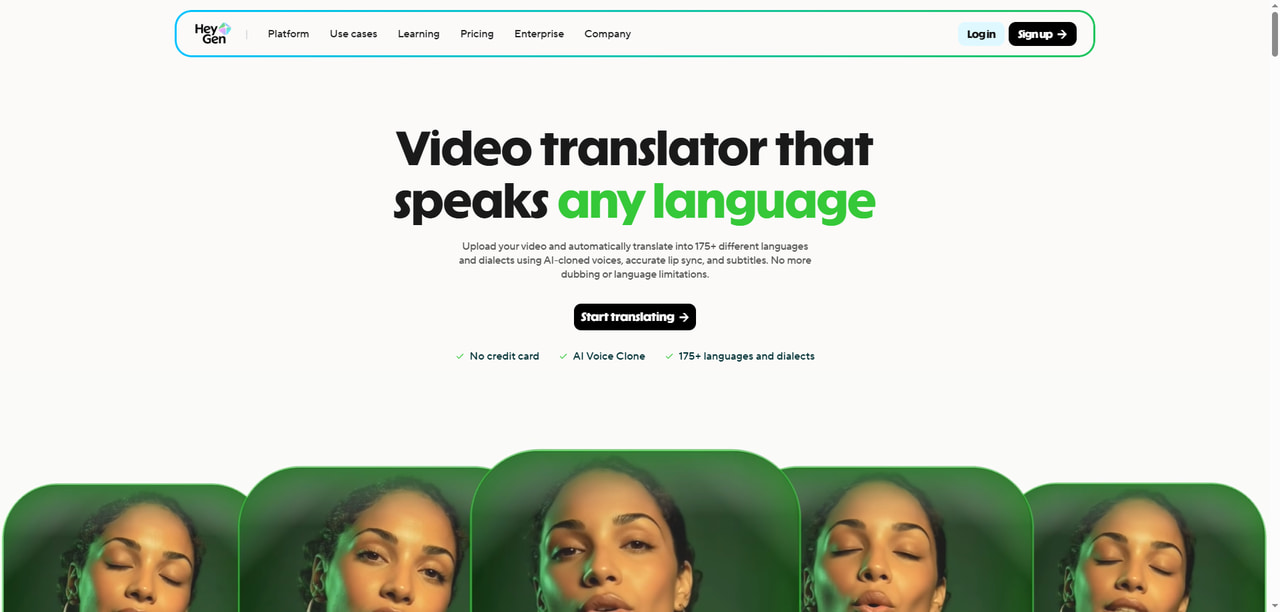
Key Features:
- 100+ supported languages and accents for global reach.
- Text-to-video generation using realistic AI avatars and cloned voices.
- Built-in lip-sync and subtitle generation for localization and accessibility.
- Template-based creation flow tailored to short-form and branded videos.
- Integration with CRM and marketing tools for automated campaigns.
Limitations:
- Focuses on avatar-driven content; less effective for translating existing video footage.
- Limited control over emotion and tone compared to voice cloning systems.
Best For: Marketers, agencies, influencers, and eCommerce brands producing personalized video ads, tutorials, or testimonials in multiple languages.
Deepdub
Deepdub is a high-end localization platform designed specifically for the film and entertainment industry. It leverages deep neural networks and AI-driven emotional voice cloning to reproduce actors’ original performances—preserving their tone, timing, and delivery across languages.
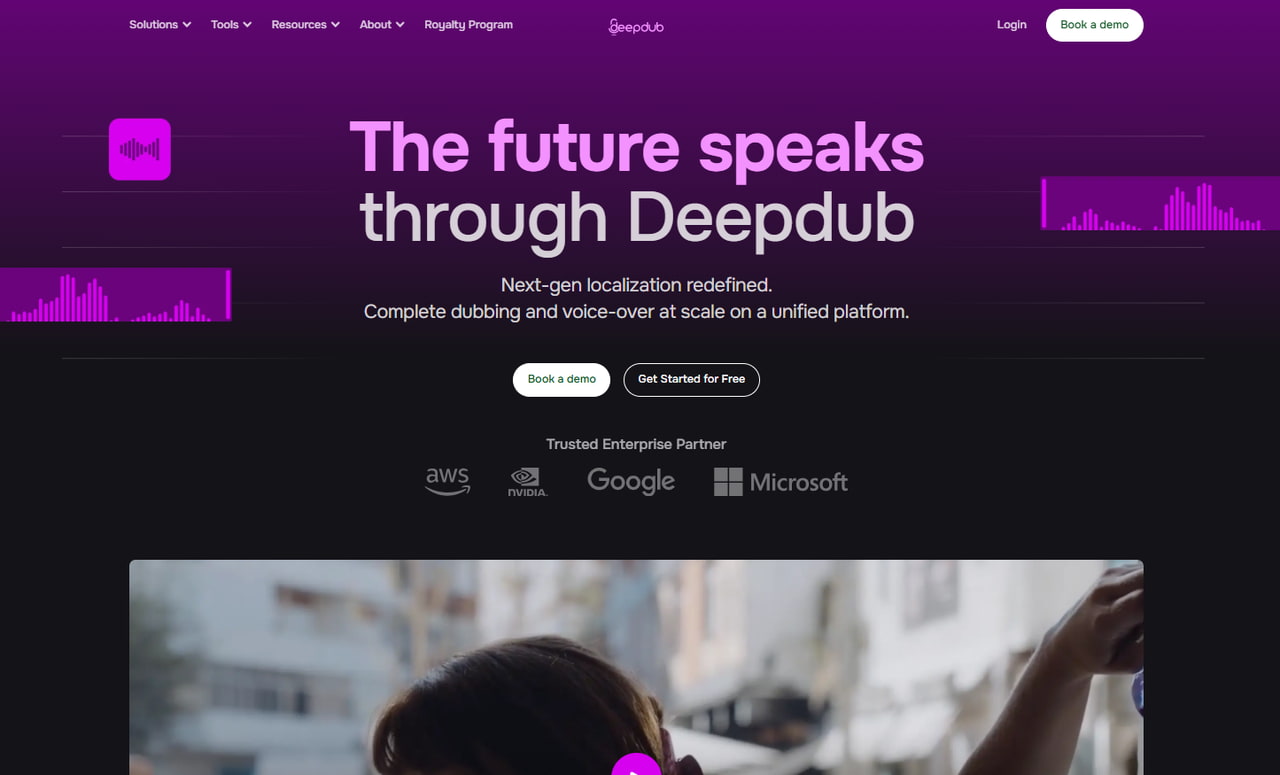
Key Features:
- Cinematic-grade dubbing with high-fidelity sound engineering.
- Emotion-aware voice cloning for natural, expressive performances.
- Enterprise-grade QC and compliance for studio workflows.
- Integration with post-production pipelines and localization teams.
- Multi-speaker synchronization for complex scenes.
Limitations:
- Enterprise pricing model—not suitable for individual creators.
- Longer onboarding process and requires professional oversight.
Best For: Film studios, streaming services (OTT), and localization agencies producing premium multilingual content for global audiences.
Descript
Descript is primarily an audio editing and voice cloning tool, widely used in podcasting, narration, and educational content creation. While it’s not a full video dubbing platform, its Overdub feature allows creators to replicate their voice for multilingual narration or corrections—without re-recording.
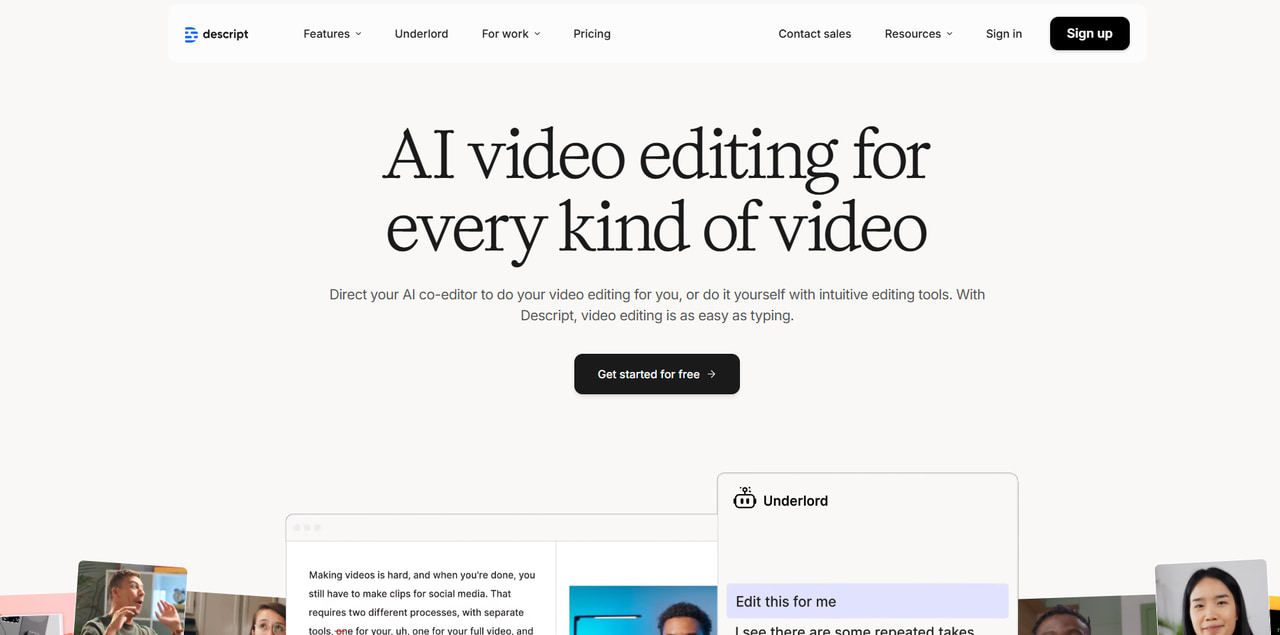
Key Features:
- AI voice cloning (Overdub) for consistent narration across multiple projects.
- Text-based editing—edit audio by editing text, similar to a document.
- Built-in subtitle and caption creation for accessibility.
- Screen recording and multitrack audio support for hybrid workflows.
- Cloud collaboration and integration with major editing tools.
Limitations:
- No built-in translation or lip-sync capabilities.
- Geared toward audio editing rather than full video localization.
Best For: Podcasters, educators, journalists, and voiceover professionals localizing spoken content or creating multilingual audio materials.
How to Localize a Video with VMEG AI
VMEG AI simplifies the entire video localization process—from uploading your clip to exporting fully dubbed videos in multiple languages. Here’s how to get started:
Step 1. Upload Your Video
Begin by uploading your video directly from your device, cloud drive, or from your existing VMEG library. VMEG supports standard formats such as MP4, MOV, and AVI, making it compatible with most editing and streaming platforms.
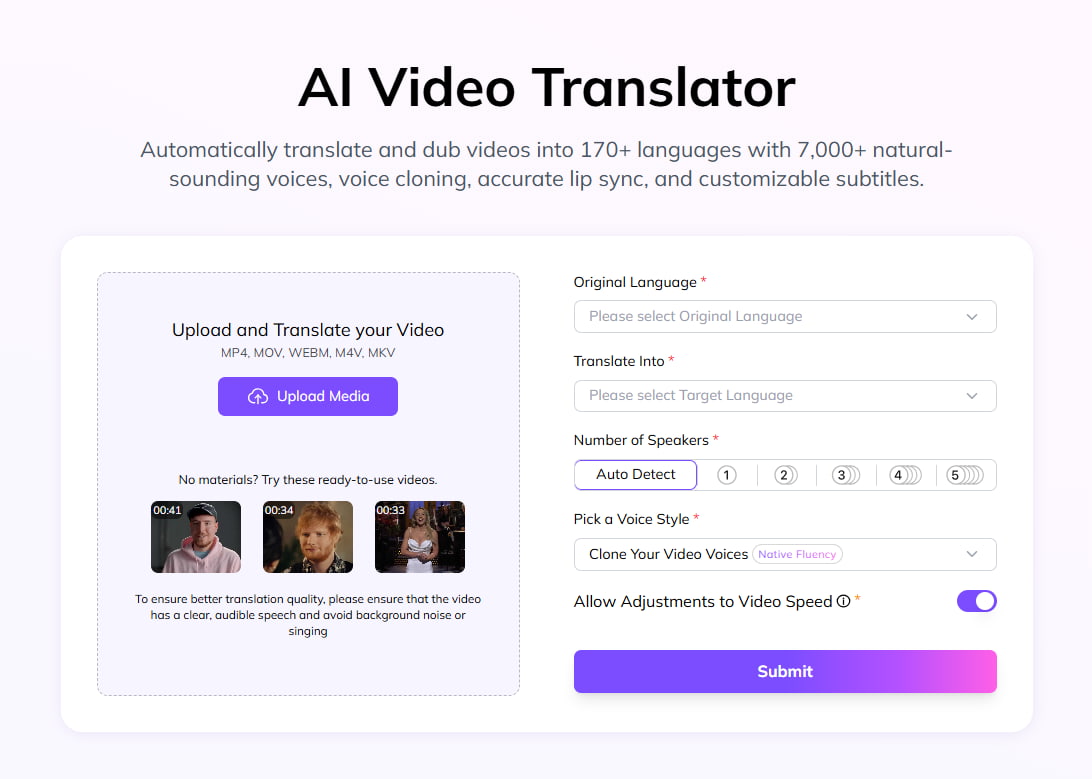
Step 2. Choose Target Languages (170+)
Select one or multiple target languages for localization. VMEG AI supports over 170 global languages, including region-specific accents and dialects. You can even translate a single video into 10+ languages simultaneously, saving time for global teams and YouTube creators.
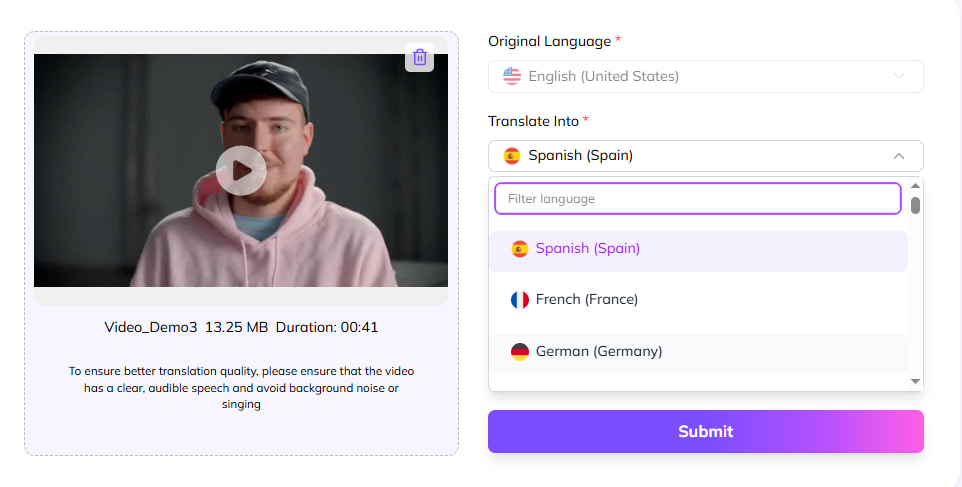
Step 3. Edit Translations & Voice Settings
Once your video is processed, you’ll see the auto-generated transcription and translation. You can edit the text line-by-line using VMEG’s in-line translation editor to refine tone, idioms, and brand-specific vocabulary.
Next, customize the voice style, gender, and tone from over 7,000 realistic AI voices—including cloned voices that perfectly match the original speaker.
Step 4. Enable AI Voice Cloning & Lip-Sync
Toggle on AI voice cloning to recreate the speaker’s natural tone and personality. VMEG’s advanced lip-sync engine aligns the new audio precisely with facial expressions and mouth movements, maintaining realism even in multilingual dubbing.
Step 5. Export the Localized Video
After reviewing your preview, export the localized output in your preferred format—MP4, MOV, or SRT subtitles. These exports are ready for YouTube, TikTok, eLearning systems, or international ad campaigns.
Top Use Cases of Video Localization
Video localization isn’t limited to one industry—it’s transforming how brands, educators, and creators connect with global audiences. Here are the most common use cases:
- Marketing & Advertising
Brands localize video ads to match cultural tone, humor, and emotion in each target market. This personalization makes campaigns more engaging and boosts conversion rates across regions.
- Education & E-Learning
Online learning platforms use multilingual voiceovers, captions, and translated course materials to reach students worldwide—ensuring accessibility for non-native speakers.
- Entertainment & Media
Studios and streaming services localize films, TV shows, and anime using AI dubbing and subtitles. Modern AI tools make it faster to deliver natural-sounding voices while preserving the actors’ performance quality.
- Corporate Training
Global companies translate training, onboarding, and compliance videos so employees everywhere can learn in their native language—improving engagement and retention.
- YouTube & Social Media Creators
Creators use AI dubbing tools to instantly translate their videos into multiple languages, helping them build global audiences without re-recording or hiring translators.
In short, video localization enables organizations across all industries to reach a broader audience, communicate effectively, and expand internationally.
Conclusion
Video localization is more than just an option. It becomes an efficient way to engage in global communication. As industries become borderless, businesses, educators, and creators are doing it their way without borders. Additionally, localized content ensures every audience feels directly addressed in their own language.
AI is a real game changer in this process; by reducing time, cost, and complexity, it has led to a revolution. Yet, the best localizations still come from both AI automation and human insight.
Whether you’re a solo creator trying to create a YouTube video with the best translation or a brand trying to expand international markets, mastering video localization helps you reach across the borders for sure.
Whether you’re a solo creator trying to create a YouTube video with the best translation or a brand trying to expand international markets, mastering video localization helps you reach across the borders for sure.
The process of adjusting video material for target markets, new languages, and cultural quirks is known as video localization.
Maintaining tone, passion, and aim while having the film feel authentic to each location is more important than just translating.
